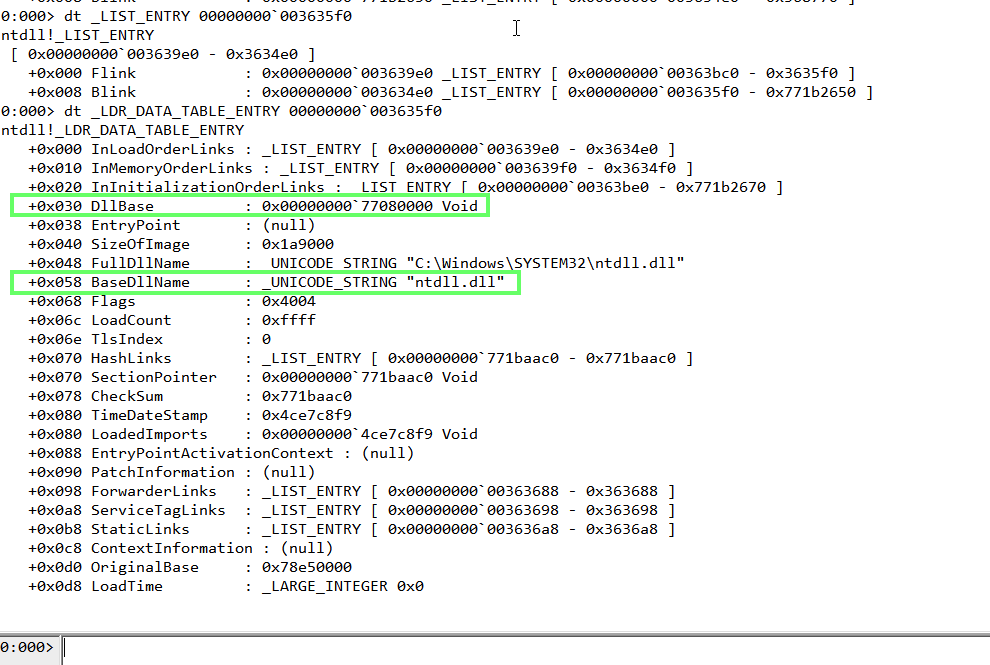How to get a DLL base address from the Process Environment Block (PEB)
We often see malware families resolving Windows APIs dynamically and abusing the built-in Windows OS structures to so. The Process Environment Block (PEB) is a structure that contains information about the process itself and the loaded modules.
PEB structure according to MSDN:
typedef struct _PEB {
BYTE Reserved1[2];
BYTE BeingDebugged;
BYTE Reserved2[1];
PVOID Reserved3[2];
PPEB_LDR_DATA Ldr;
PRTL_USER_PROCESS_PARAMETERS ProcessParameters;
PVOID Reserved4[3];
PVOID AtlThunkSListPtr;
PVOID Reserved5;
ULONG Reserved6;
PVOID Reserved7;
ULONG Reserved8;
ULONG AtlThunkSListPtr32;
PVOID Reserved9[45];
BYTE Reserved10[96];
PPS_POST_PROCESS_INIT_ROUTINE PostProcessInitRoutine;
BYTE Reserved11[128];
PVOID Reserved12[1];
ULONG SessionId;
} PEB, *PPEB;
One way of getting the pointer to PEB is, for example, by accessing a specific offset using the FS or GS register depending on the architecture.
- FS[0x30] - FS offset to PEB for 32 bit Windows
- GS[0x60] - GS offset to PEB for 64 bit Windows
Here’s a C code snippet to get a pointer to PEB:
#ifndef _WIN64
PEB* peb = (PEB*) __readfsdword(0x30);
#else
PEB* peb = (PEB*) __readgsqword(0x60);
#endif
Having the PEB pointer it is now possible to access the PEB.Ldr field which points to a PEB_LDR_DATA structure.
0:000> dt ntdll!_PEB_LDR_DATA
+0x000 Length : Uint4B
+0x004 Initialized : UChar
+0x008 SsHandle : Ptr64 Void
+0x010 InLoadOrderModuleList : _LIST_ENTRY
+0x020 InMemoryOrderModuleList : _LIST_ENTRY
+0x030 InInitializationOrderModuleList : _LIST_ENTRY
+0x040 EntryInProgress : Ptr64 Void
+0x048 ShutdownInProgress : UChar
+0x050 ShutdownThreadId : Ptr64 Void
The PEB_LDR_DATA.InLoadOrderModuleList field points to a LIST_ENTRY structure.
As seen below, a LIST_ENTRY structure is a double-linked list that contains two pointers. One pointer is for the next LIST_ENTRY structure, while the other is for the previous one.
0:000> dt ntdll!_LIST_ENTRY
+0x000 Flink : Ptr64 _LIST_ENTRY
+0x008 Blink : Ptr64 _LIST_ENTRY
The trick is that these LIST_ENTRY pointers are part of a another structure (a bigger one), which contains more data. This structure is named LDR_DATA_TABLE_ENTRY and below we can see its definition:
0:000> dt ntdll!_LDR_DATA_TABLE_ENTRY
ntdll!_LDR_DATA_TABLE_ENTRY
+0x000 InLoadOrderLinks : _LIST_ENTRY
+0x010 InMemoryOrderLinks : _LIST_ENTRY
+0x020 InInitializationOrderLinks : _LIST_ENTRY
+0x030 DllBase : Ptr64 Void
+0x038 EntryPoint : Ptr64 Void
+0x040 SizeOfImage : Uint4B
+0x048 FullDllName : _UNICODE_STRING
+0x058 BaseDllName : _UNICODE_STRING
+0x068 Flags : Uint4B
+0x06c LoadCount : Uint2B
+0x06e TlsIndex : Uint2B
+0x070 HashLinks : _LIST_ENTRY
+0x070 SectionPointer : Ptr64 Void
+0x078 CheckSum : Uint4B
+0x080 TimeDateStamp : Uint4B
+0x080 LoadedImports : Ptr64 Void
+0x088 EntryPointActivationContext : Ptr64 _ACTIVATION_CONTEXT
+0x090 PatchInformation : Ptr64 Void
+0x098 ForwarderLinks : _LIST_ENTRY
+0x0a8 ServiceTagLinks : _LIST_ENTRY
+0x0b8 StaticLinks : _LIST_ENTRY
+0x0c8 ContextInformation : Ptr64 Void
+0x0d0 OriginalBase : Uint8B
+0x0d8 LoadTime : _LARGE_INTEGER
So if we cast a LIST_ENTRY pointer obtained from PEB_LDR_DATA.InLoadOrderModuleList as a LDR_DATA_TABLE_ENTRY pointer, we get access to more fields such as the BaseDllName and the DllBase:

Here is a snippet of code that uses this technique to obtain the base address of a DLL:
